7207MKT Market Research Report: Blood Donation in Australia
VerifiedAdded on 2022/08/18
|8
|2461
|328
Report
AI Summary
This report presents a market research analysis focused on blood donation in Australia, commissioned by the Red Cross. The study investigates the characteristics of the eligible donor market segment, exploring factors that motivate individuals to donate blood and identifying existing barriers that deter them. A comprehensive literature review examines existing research on blood donation, including the impact of incentives, public attitudes, and the influence of diseases like dengue fever on donation rates. The report also addresses the importance of communication channels in reaching potential donors and enhancing marketing strategies to improve donation rates. The research aims to address gaps in current literature by analyzing demographic and psychographic factors influencing donor behavior. The findings highlight the need for effective marketing strategies to increase blood donation rates within the Australian population, addressing current needs and anticipated future demands. The report emphasizes the importance of understanding donor motivations and barriers to improve the effectiveness of blood donation campaigns.
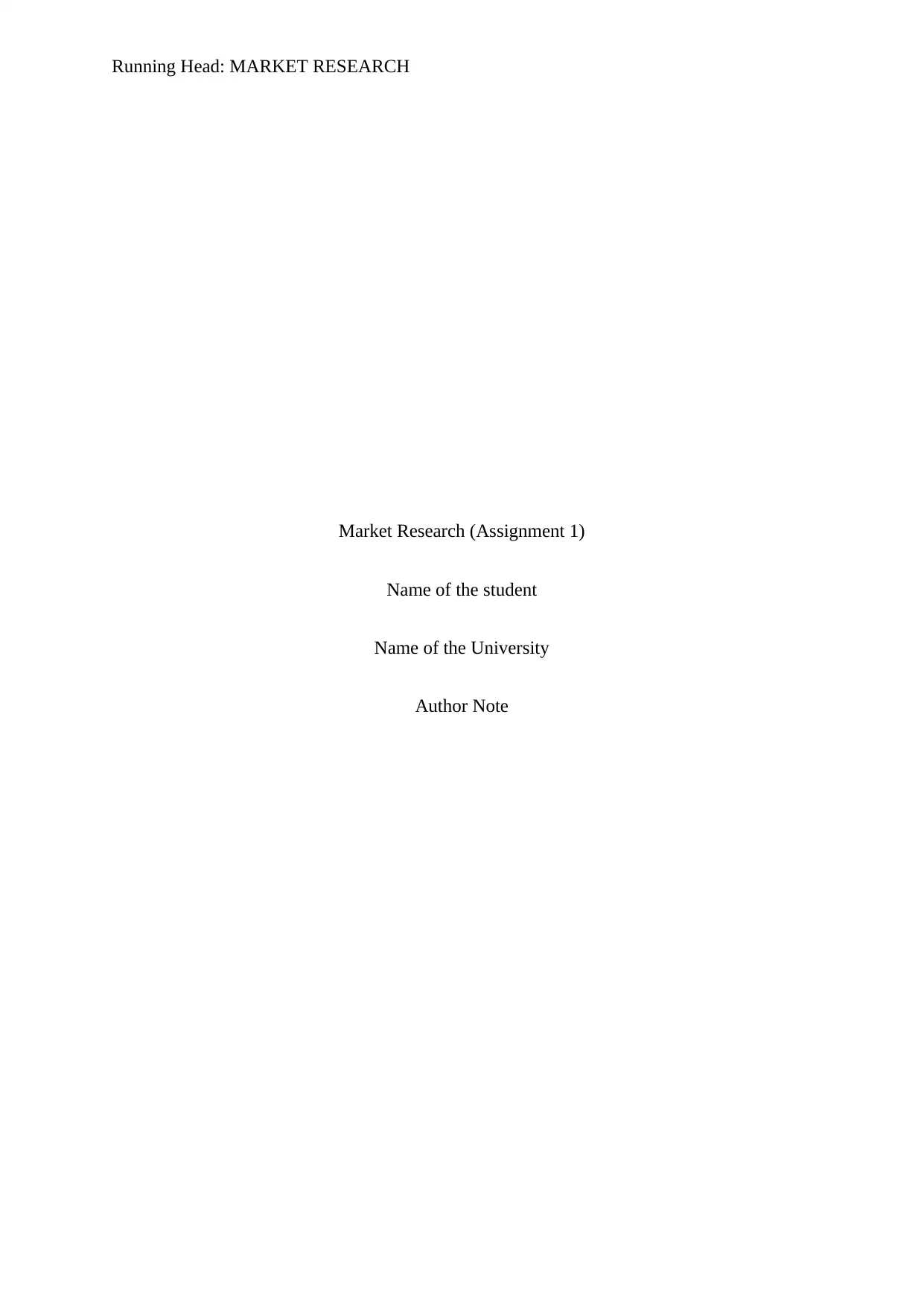
Running Head: MARKET RESEARCH
Market Research (Assignment 1)
Name of the student
Name of the University
Author Note
Market Research (Assignment 1)
Name of the student
Name of the University
Author Note
Paraphrase This Document
Need a fresh take? Get an instant paraphrase of this document with our AI Paraphraser
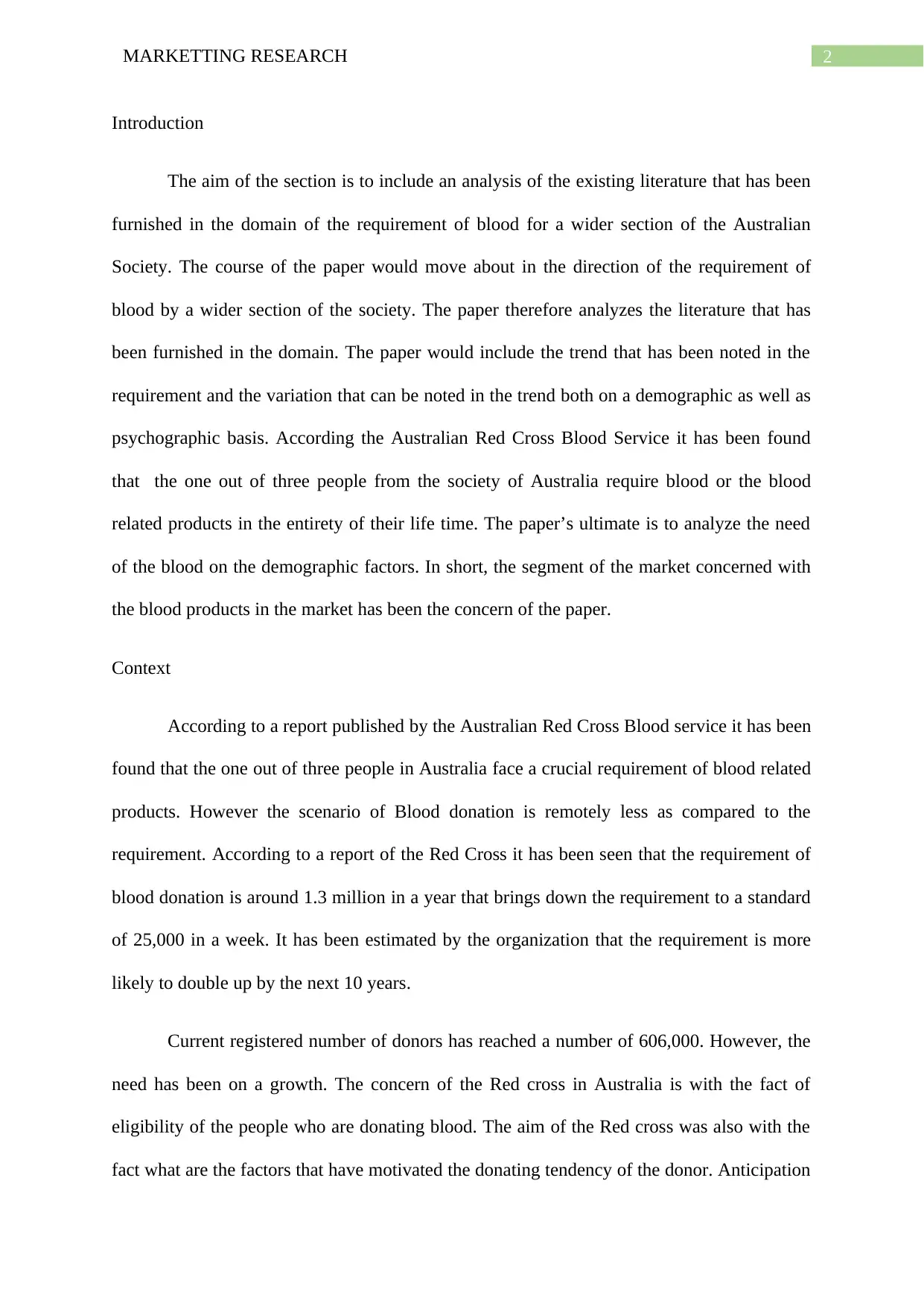
2MARKETTING RESEARCH
Introduction
The aim of the section is to include an analysis of the existing literature that has been
furnished in the domain of the requirement of blood for a wider section of the Australian
Society. The course of the paper would move about in the direction of the requirement of
blood by a wider section of the society. The paper therefore analyzes the literature that has
been furnished in the domain. The paper would include the trend that has been noted in the
requirement and the variation that can be noted in the trend both on a demographic as well as
psychographic basis. According the Australian Red Cross Blood Service it has been found
that the one out of three people from the society of Australia require blood or the blood
related products in the entirety of their life time. The paper’s ultimate is to analyze the need
of the blood on the demographic factors. In short, the segment of the market concerned with
the blood products in the market has been the concern of the paper.
Context
According to a report published by the Australian Red Cross Blood service it has been
found that the one out of three people in Australia face a crucial requirement of blood related
products. However the scenario of Blood donation is remotely less as compared to the
requirement. According to a report of the Red Cross it has been seen that the requirement of
blood donation is around 1.3 million in a year that brings down the requirement to a standard
of 25,000 in a week. It has been estimated by the organization that the requirement is more
likely to double up by the next 10 years.
Current registered number of donors has reached a number of 606,000. However, the
need has been on a growth. The concern of the Red cross in Australia is with the fact of
eligibility of the people who are donating blood. The aim of the Red cross was also with the
fact what are the factors that have motivated the donating tendency of the donor. Anticipation
Introduction
The aim of the section is to include an analysis of the existing literature that has been
furnished in the domain of the requirement of blood for a wider section of the Australian
Society. The course of the paper would move about in the direction of the requirement of
blood by a wider section of the society. The paper therefore analyzes the literature that has
been furnished in the domain. The paper would include the trend that has been noted in the
requirement and the variation that can be noted in the trend both on a demographic as well as
psychographic basis. According the Australian Red Cross Blood Service it has been found
that the one out of three people from the society of Australia require blood or the blood
related products in the entirety of their life time. The paper’s ultimate is to analyze the need
of the blood on the demographic factors. In short, the segment of the market concerned with
the blood products in the market has been the concern of the paper.
Context
According to a report published by the Australian Red Cross Blood service it has been
found that the one out of three people in Australia face a crucial requirement of blood related
products. However the scenario of Blood donation is remotely less as compared to the
requirement. According to a report of the Red Cross it has been seen that the requirement of
blood donation is around 1.3 million in a year that brings down the requirement to a standard
of 25,000 in a week. It has been estimated by the organization that the requirement is more
likely to double up by the next 10 years.
Current registered number of donors has reached a number of 606,000. However, the
need has been on a growth. The concern of the Red cross in Australia is with the fact of
eligibility of the people who are donating blood. The aim of the Red cross was also with the
fact what are the factors that have motivated the donating tendency of the donor. Anticipation
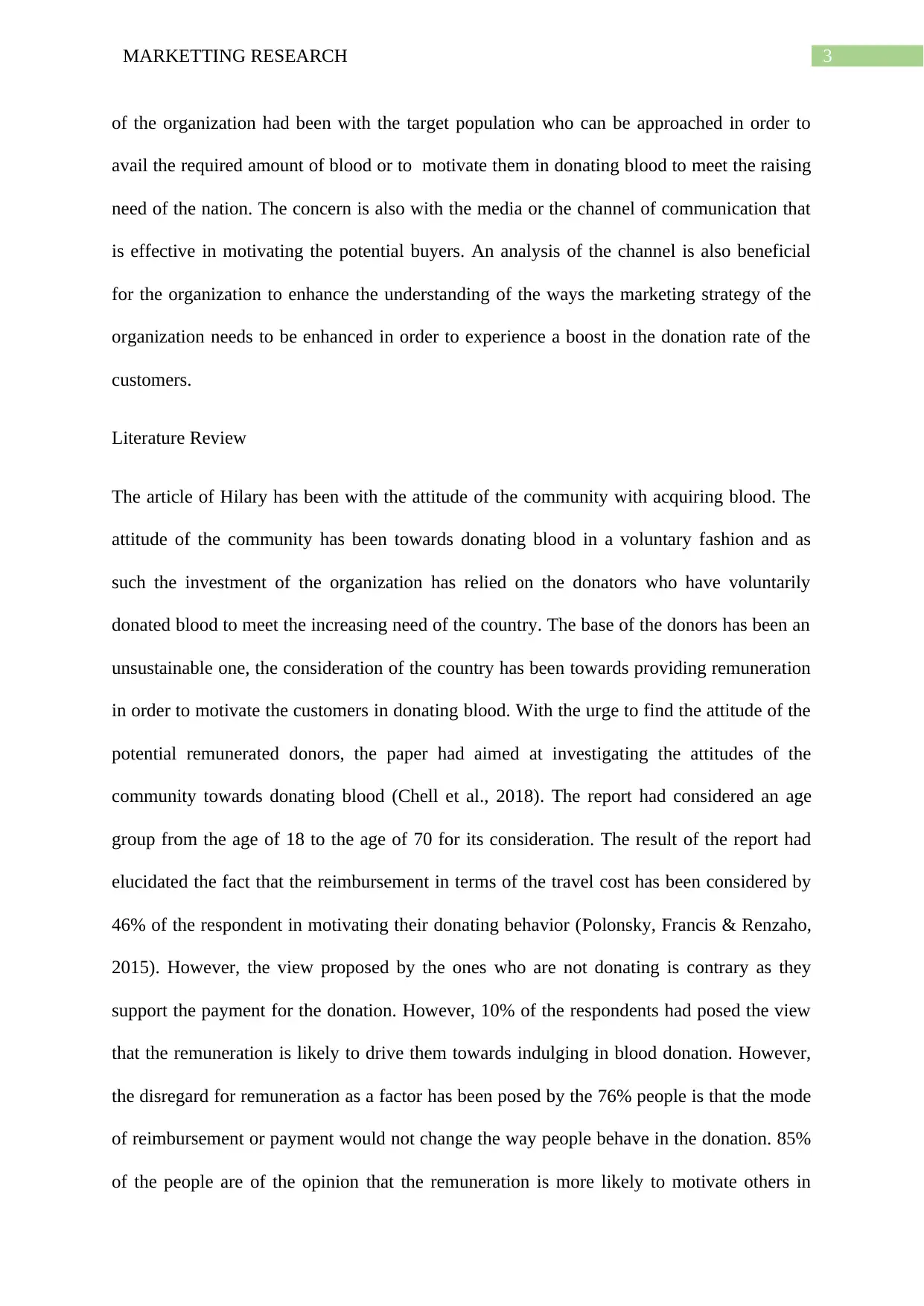
3MARKETTING RESEARCH
of the organization had been with the target population who can be approached in order to
avail the required amount of blood or to motivate them in donating blood to meet the raising
need of the nation. The concern is also with the media or the channel of communication that
is effective in motivating the potential buyers. An analysis of the channel is also beneficial
for the organization to enhance the understanding of the ways the marketing strategy of the
organization needs to be enhanced in order to experience a boost in the donation rate of the
customers.
Literature Review
The article of Hilary has been with the attitude of the community with acquiring blood. The
attitude of the community has been towards donating blood in a voluntary fashion and as
such the investment of the organization has relied on the donators who have voluntarily
donated blood to meet the increasing need of the country. The base of the donors has been an
unsustainable one, the consideration of the country has been towards providing remuneration
in order to motivate the customers in donating blood. With the urge to find the attitude of the
potential remunerated donors, the paper had aimed at investigating the attitudes of the
community towards donating blood (Chell et al., 2018). The report had considered an age
group from the age of 18 to the age of 70 for its consideration. The result of the report had
elucidated the fact that the reimbursement in terms of the travel cost has been considered by
46% of the respondent in motivating their donating behavior (Polonsky, Francis & Renzaho,
2015). However, the view proposed by the ones who are not donating is contrary as they
support the payment for the donation. However, 10% of the respondents had posed the view
that the remuneration is likely to drive them towards indulging in blood donation. However,
the disregard for remuneration as a factor has been posed by the 76% people is that the mode
of reimbursement or payment would not change the way people behave in the donation. 85%
of the people are of the opinion that the remuneration is more likely to motivate others in
of the organization had been with the target population who can be approached in order to
avail the required amount of blood or to motivate them in donating blood to meet the raising
need of the nation. The concern is also with the media or the channel of communication that
is effective in motivating the potential buyers. An analysis of the channel is also beneficial
for the organization to enhance the understanding of the ways the marketing strategy of the
organization needs to be enhanced in order to experience a boost in the donation rate of the
customers.
Literature Review
The article of Hilary has been with the attitude of the community with acquiring blood. The
attitude of the community has been towards donating blood in a voluntary fashion and as
such the investment of the organization has relied on the donators who have voluntarily
donated blood to meet the increasing need of the country. The base of the donors has been an
unsustainable one, the consideration of the country has been towards providing remuneration
in order to motivate the customers in donating blood. With the urge to find the attitude of the
potential remunerated donors, the paper had aimed at investigating the attitudes of the
community towards donating blood (Chell et al., 2018). The report had considered an age
group from the age of 18 to the age of 70 for its consideration. The result of the report had
elucidated the fact that the reimbursement in terms of the travel cost has been considered by
46% of the respondent in motivating their donating behavior (Polonsky, Francis & Renzaho,
2015). However, the view proposed by the ones who are not donating is contrary as they
support the payment for the donation. However, 10% of the respondents had posed the view
that the remuneration is likely to drive them towards indulging in blood donation. However,
the disregard for remuneration as a factor has been posed by the 76% people is that the mode
of reimbursement or payment would not change the way people behave in the donation. 85%
of the people are of the opinion that the remuneration is more likely to motivate others in
⊘ This is a preview!⊘
Do you want full access?
Subscribe today to unlock all pages.

Trusted by 1+ million students worldwide
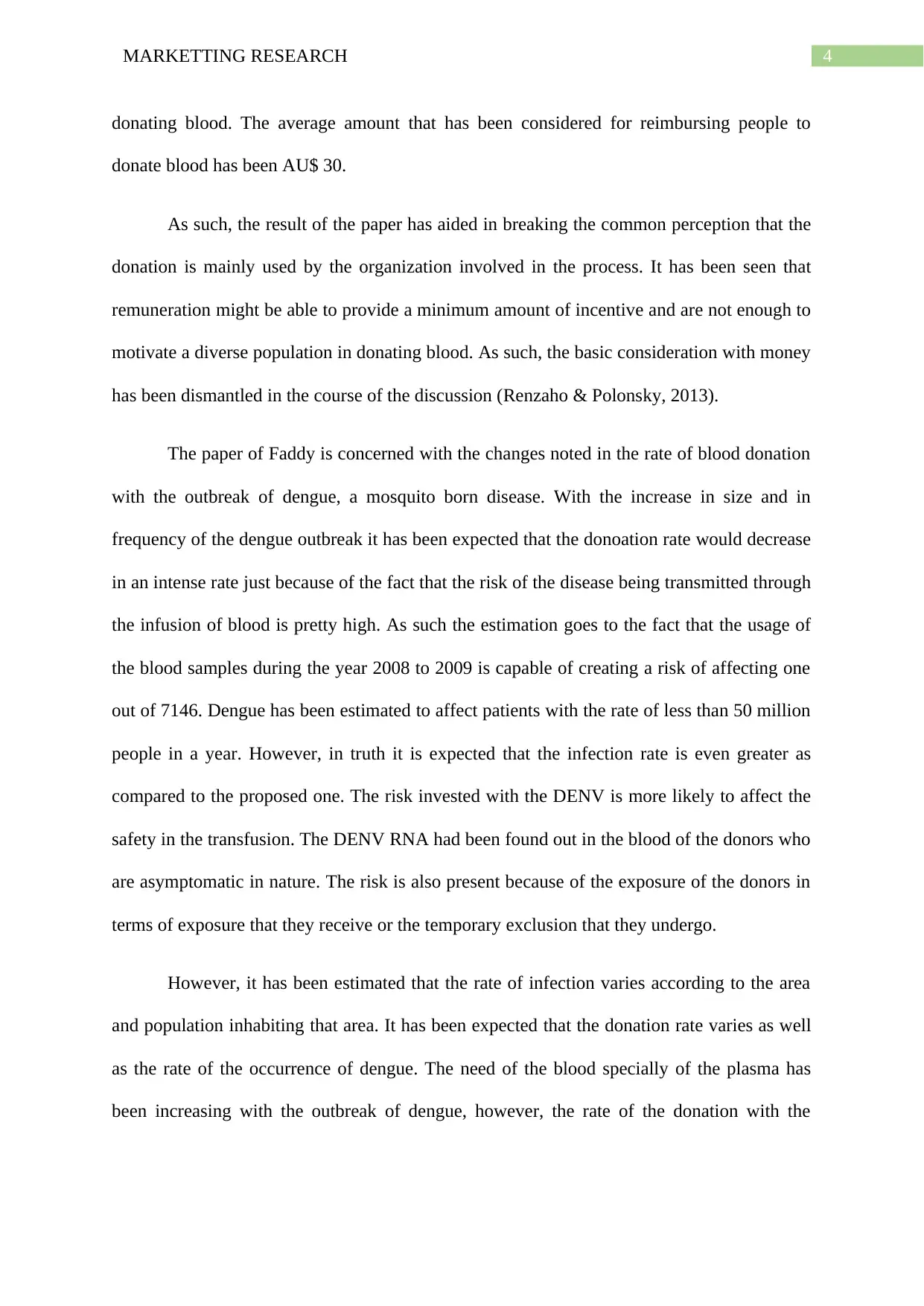
4MARKETTING RESEARCH
donating blood. The average amount that has been considered for reimbursing people to
donate blood has been AU$ 30.
As such, the result of the paper has aided in breaking the common perception that the
donation is mainly used by the organization involved in the process. It has been seen that
remuneration might be able to provide a minimum amount of incentive and are not enough to
motivate a diverse population in donating blood. As such, the basic consideration with money
has been dismantled in the course of the discussion (Renzaho & Polonsky, 2013).
The paper of Faddy is concerned with the changes noted in the rate of blood donation
with the outbreak of dengue, a mosquito born disease. With the increase in size and in
frequency of the dengue outbreak it has been expected that the donoation rate would decrease
in an intense rate just because of the fact that the risk of the disease being transmitted through
the infusion of blood is pretty high. As such the estimation goes to the fact that the usage of
the blood samples during the year 2008 to 2009 is capable of creating a risk of affecting one
out of 7146. Dengue has been estimated to affect patients with the rate of less than 50 million
people in a year. However, in truth it is expected that the infection rate is even greater as
compared to the proposed one. The risk invested with the DENV is more likely to affect the
safety in the transfusion. The DENV RNA had been found out in the blood of the donors who
are asymptomatic in nature. The risk is also present because of the exposure of the donors in
terms of exposure that they receive or the temporary exclusion that they undergo.
However, it has been estimated that the rate of infection varies according to the area
and population inhabiting that area. It has been expected that the donation rate varies as well
as the rate of the occurrence of dengue. The need of the blood specially of the plasma has
been increasing with the outbreak of dengue, however, the rate of the donation with the
donating blood. The average amount that has been considered for reimbursing people to
donate blood has been AU$ 30.
As such, the result of the paper has aided in breaking the common perception that the
donation is mainly used by the organization involved in the process. It has been seen that
remuneration might be able to provide a minimum amount of incentive and are not enough to
motivate a diverse population in donating blood. As such, the basic consideration with money
has been dismantled in the course of the discussion (Renzaho & Polonsky, 2013).
The paper of Faddy is concerned with the changes noted in the rate of blood donation
with the outbreak of dengue, a mosquito born disease. With the increase in size and in
frequency of the dengue outbreak it has been expected that the donoation rate would decrease
in an intense rate just because of the fact that the risk of the disease being transmitted through
the infusion of blood is pretty high. As such the estimation goes to the fact that the usage of
the blood samples during the year 2008 to 2009 is capable of creating a risk of affecting one
out of 7146. Dengue has been estimated to affect patients with the rate of less than 50 million
people in a year. However, in truth it is expected that the infection rate is even greater as
compared to the proposed one. The risk invested with the DENV is more likely to affect the
safety in the transfusion. The DENV RNA had been found out in the blood of the donors who
are asymptomatic in nature. The risk is also present because of the exposure of the donors in
terms of exposure that they receive or the temporary exclusion that they undergo.
However, it has been estimated that the rate of infection varies according to the area
and population inhabiting that area. It has been expected that the donation rate varies as well
as the rate of the occurrence of dengue. The need of the blood specially of the plasma has
been increasing with the outbreak of dengue, however, the rate of the donation with the
Paraphrase This Document
Need a fresh take? Get an instant paraphrase of this document with our AI Paraphraser
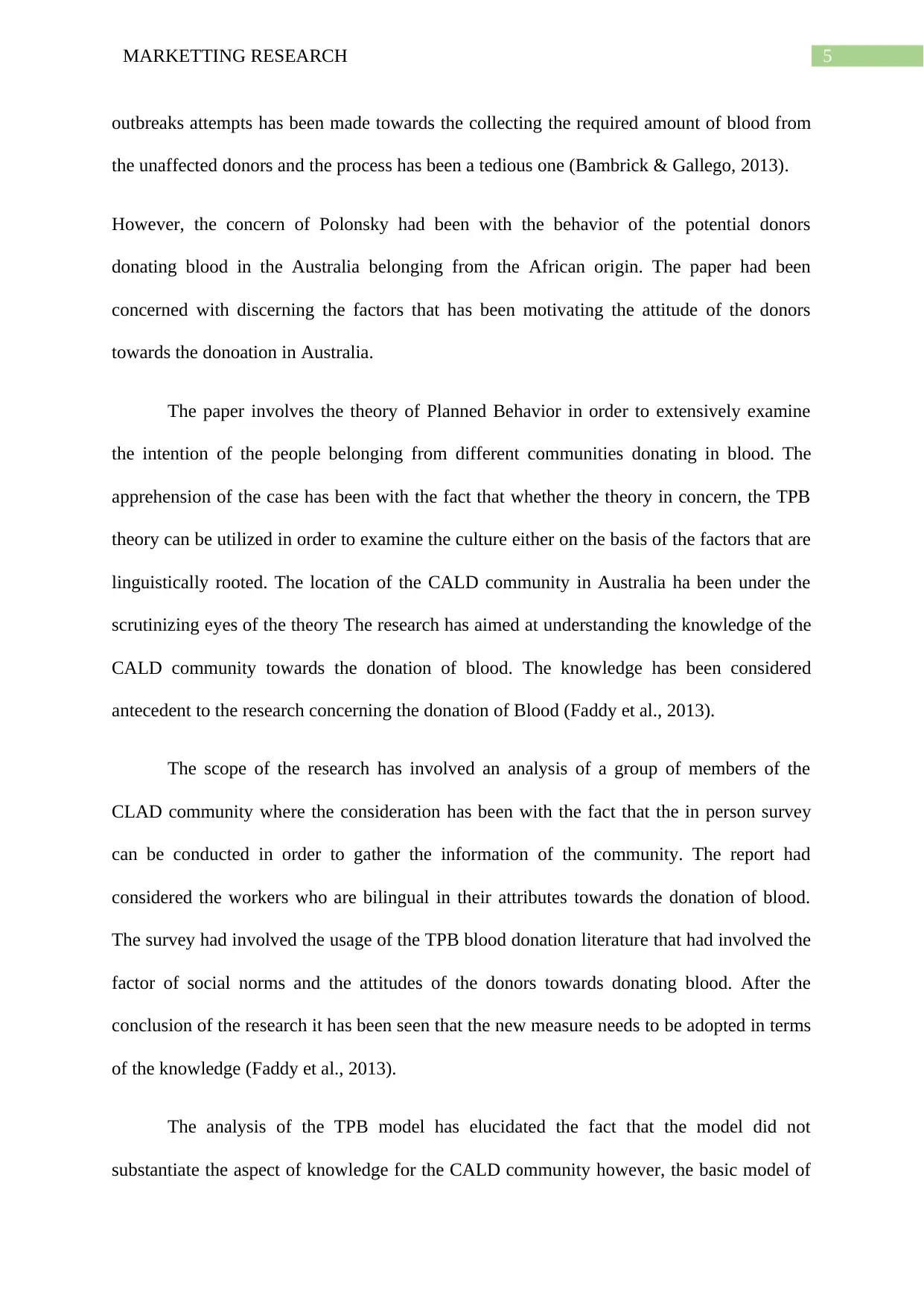
5MARKETTING RESEARCH
outbreaks attempts has been made towards the collecting the required amount of blood from
the unaffected donors and the process has been a tedious one (Bambrick & Gallego, 2013).
However, the concern of Polonsky had been with the behavior of the potential donors
donating blood in the Australia belonging from the African origin. The paper had been
concerned with discerning the factors that has been motivating the attitude of the donors
towards the donoation in Australia.
The paper involves the theory of Planned Behavior in order to extensively examine
the intention of the people belonging from different communities donating in blood. The
apprehension of the case has been with the fact that whether the theory in concern, the TPB
theory can be utilized in order to examine the culture either on the basis of the factors that are
linguistically rooted. The location of the CALD community in Australia ha been under the
scrutinizing eyes of the theory The research has aimed at understanding the knowledge of the
CALD community towards the donation of blood. The knowledge has been considered
antecedent to the research concerning the donation of Blood (Faddy et al., 2013).
The scope of the research has involved an analysis of a group of members of the
CLAD community where the consideration has been with the fact that the in person survey
can be conducted in order to gather the information of the community. The report had
considered the workers who are bilingual in their attributes towards the donation of blood.
The survey had involved the usage of the TPB blood donation literature that had involved the
factor of social norms and the attitudes of the donors towards donating blood. After the
conclusion of the research it has been seen that the new measure needs to be adopted in terms
of the knowledge (Faddy et al., 2013).
The analysis of the TPB model has elucidated the fact that the model did not
substantiate the aspect of knowledge for the CALD community however, the basic model of
outbreaks attempts has been made towards the collecting the required amount of blood from
the unaffected donors and the process has been a tedious one (Bambrick & Gallego, 2013).
However, the concern of Polonsky had been with the behavior of the potential donors
donating blood in the Australia belonging from the African origin. The paper had been
concerned with discerning the factors that has been motivating the attitude of the donors
towards the donoation in Australia.
The paper involves the theory of Planned Behavior in order to extensively examine
the intention of the people belonging from different communities donating in blood. The
apprehension of the case has been with the fact that whether the theory in concern, the TPB
theory can be utilized in order to examine the culture either on the basis of the factors that are
linguistically rooted. The location of the CALD community in Australia ha been under the
scrutinizing eyes of the theory The research has aimed at understanding the knowledge of the
CALD community towards the donation of blood. The knowledge has been considered
antecedent to the research concerning the donation of Blood (Faddy et al., 2013).
The scope of the research has involved an analysis of a group of members of the
CLAD community where the consideration has been with the fact that the in person survey
can be conducted in order to gather the information of the community. The report had
considered the workers who are bilingual in their attributes towards the donation of blood.
The survey had involved the usage of the TPB blood donation literature that had involved the
factor of social norms and the attitudes of the donors towards donating blood. After the
conclusion of the research it has been seen that the new measure needs to be adopted in terms
of the knowledge (Faddy et al., 2013).
The analysis of the TPB model has elucidated the fact that the model did not
substantiate the aspect of knowledge for the CALD community however, the basic model of
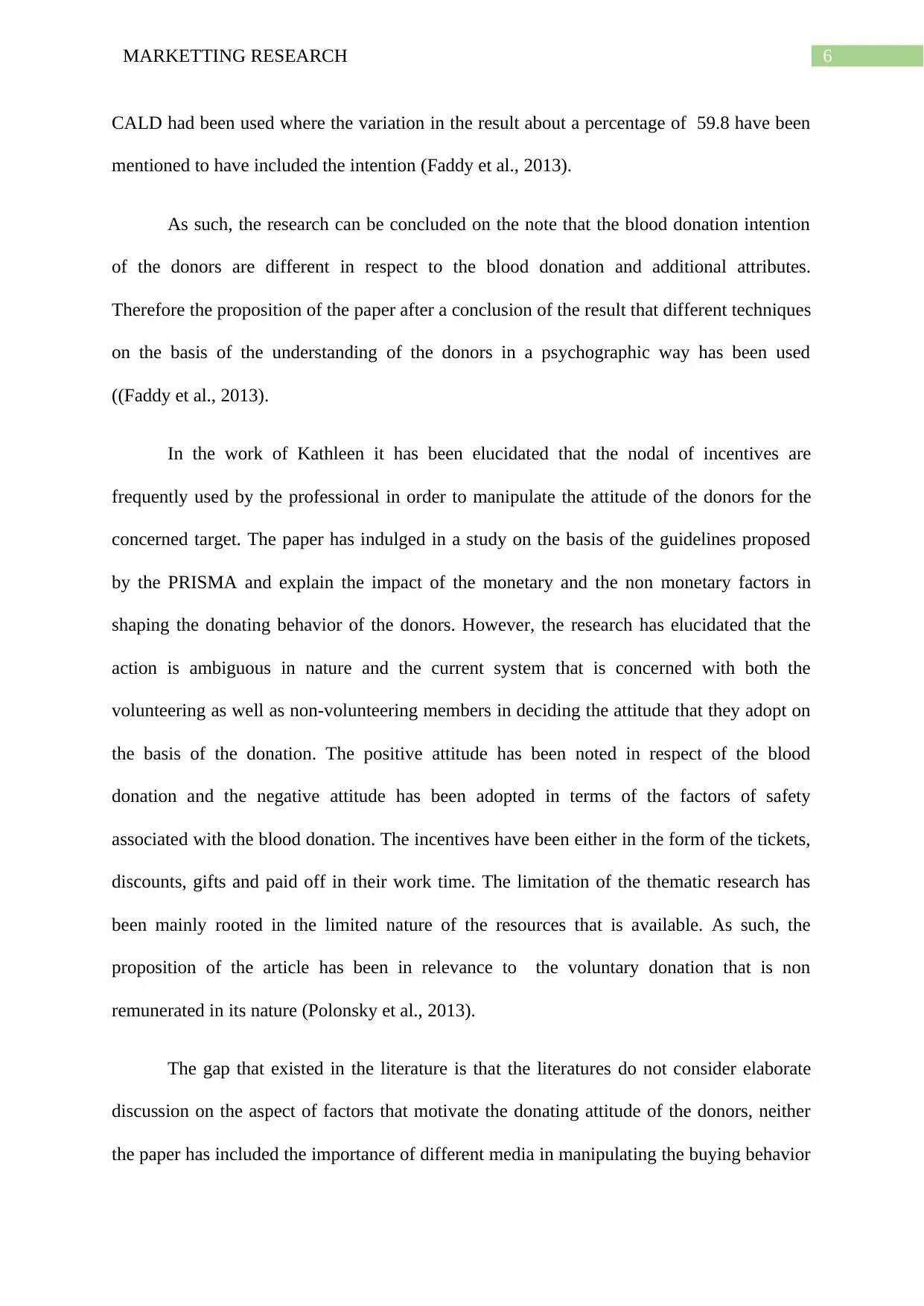
6MARKETTING RESEARCH
CALD had been used where the variation in the result about a percentage of 59.8 have been
mentioned to have included the intention (Faddy et al., 2013).
As such, the research can be concluded on the note that the blood donation intention
of the donors are different in respect to the blood donation and additional attributes.
Therefore the proposition of the paper after a conclusion of the result that different techniques
on the basis of the understanding of the donors in a psychographic way has been used
((Faddy et al., 2013).
In the work of Kathleen it has been elucidated that the nodal of incentives are
frequently used by the professional in order to manipulate the attitude of the donors for the
concerned target. The paper has indulged in a study on the basis of the guidelines proposed
by the PRISMA and explain the impact of the monetary and the non monetary factors in
shaping the donating behavior of the donors. However, the research has elucidated that the
action is ambiguous in nature and the current system that is concerned with both the
volunteering as well as non-volunteering members in deciding the attitude that they adopt on
the basis of the donation. The positive attitude has been noted in respect of the blood
donation and the negative attitude has been adopted in terms of the factors of safety
associated with the blood donation. The incentives have been either in the form of the tickets,
discounts, gifts and paid off in their work time. The limitation of the thematic research has
been mainly rooted in the limited nature of the resources that is available. As such, the
proposition of the article has been in relevance to the voluntary donation that is non
remunerated in its nature (Polonsky et al., 2013).
The gap that existed in the literature is that the literatures do not consider elaborate
discussion on the aspect of factors that motivate the donating attitude of the donors, neither
the paper has included the importance of different media in manipulating the buying behavior
CALD had been used where the variation in the result about a percentage of 59.8 have been
mentioned to have included the intention (Faddy et al., 2013).
As such, the research can be concluded on the note that the blood donation intention
of the donors are different in respect to the blood donation and additional attributes.
Therefore the proposition of the paper after a conclusion of the result that different techniques
on the basis of the understanding of the donors in a psychographic way has been used
((Faddy et al., 2013).
In the work of Kathleen it has been elucidated that the nodal of incentives are
frequently used by the professional in order to manipulate the attitude of the donors for the
concerned target. The paper has indulged in a study on the basis of the guidelines proposed
by the PRISMA and explain the impact of the monetary and the non monetary factors in
shaping the donating behavior of the donors. However, the research has elucidated that the
action is ambiguous in nature and the current system that is concerned with both the
volunteering as well as non-volunteering members in deciding the attitude that they adopt on
the basis of the donation. The positive attitude has been noted in respect of the blood
donation and the negative attitude has been adopted in terms of the factors of safety
associated with the blood donation. The incentives have been either in the form of the tickets,
discounts, gifts and paid off in their work time. The limitation of the thematic research has
been mainly rooted in the limited nature of the resources that is available. As such, the
proposition of the article has been in relevance to the voluntary donation that is non
remunerated in its nature (Polonsky et al., 2013).
The gap that existed in the literature is that the literatures do not consider elaborate
discussion on the aspect of factors that motivate the donating attitude of the donors, neither
the paper has included the importance of different media in manipulating the buying behavior
⊘ This is a preview!⊘
Do you want full access?
Subscribe today to unlock all pages.

Trusted by 1+ million students worldwide
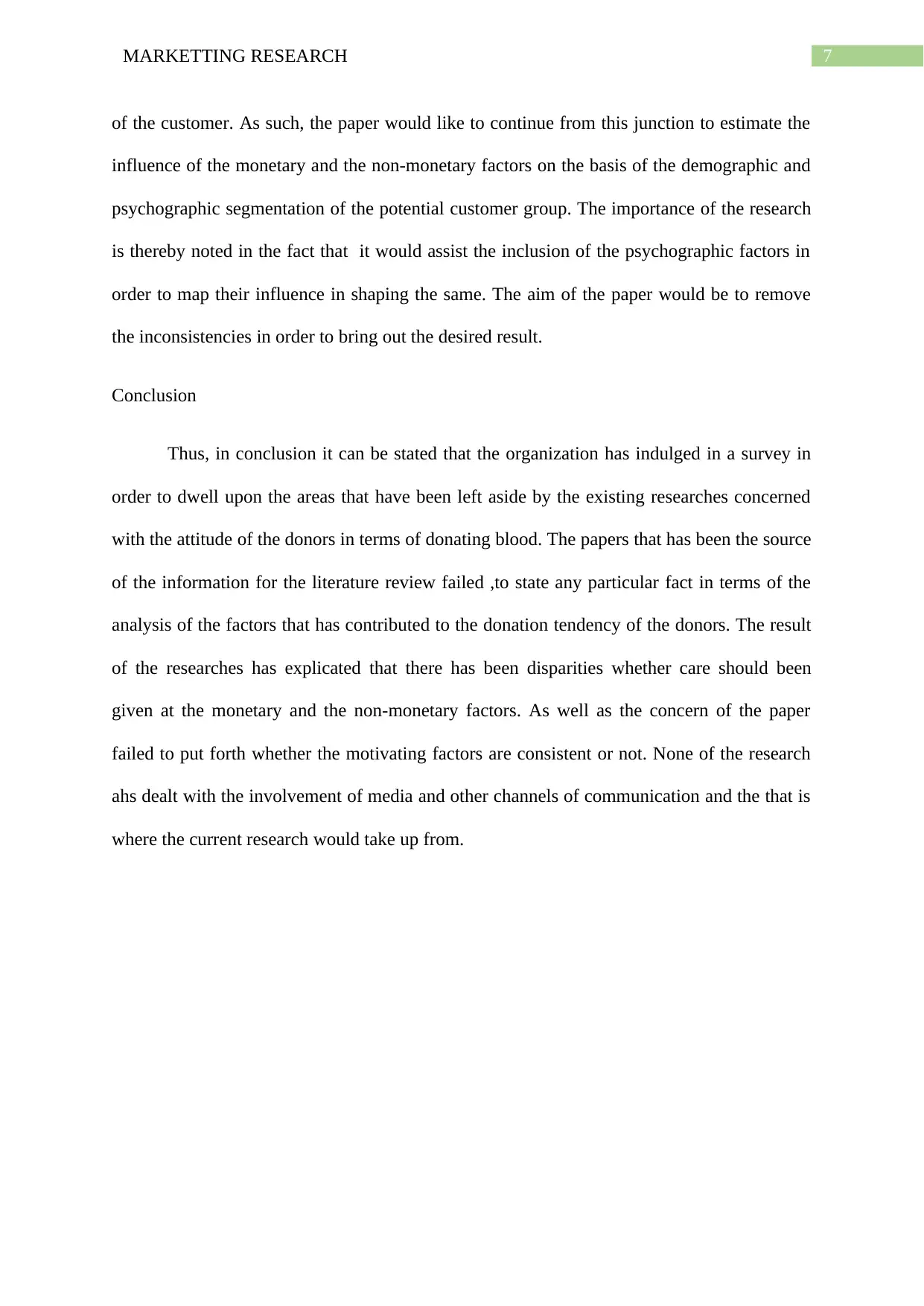
7MARKETTING RESEARCH
of the customer. As such, the paper would like to continue from this junction to estimate the
influence of the monetary and the non-monetary factors on the basis of the demographic and
psychographic segmentation of the potential customer group. The importance of the research
is thereby noted in the fact that it would assist the inclusion of the psychographic factors in
order to map their influence in shaping the same. The aim of the paper would be to remove
the inconsistencies in order to bring out the desired result.
Conclusion
Thus, in conclusion it can be stated that the organization has indulged in a survey in
order to dwell upon the areas that have been left aside by the existing researches concerned
with the attitude of the donors in terms of donating blood. The papers that has been the source
of the information for the literature review failed ,to state any particular fact in terms of the
analysis of the factors that has contributed to the donation tendency of the donors. The result
of the researches has explicated that there has been disparities whether care should been
given at the monetary and the non-monetary factors. As well as the concern of the paper
failed to put forth whether the motivating factors are consistent or not. None of the research
ahs dealt with the involvement of media and other channels of communication and the that is
where the current research would take up from.
of the customer. As such, the paper would like to continue from this junction to estimate the
influence of the monetary and the non-monetary factors on the basis of the demographic and
psychographic segmentation of the potential customer group. The importance of the research
is thereby noted in the fact that it would assist the inclusion of the psychographic factors in
order to map their influence in shaping the same. The aim of the paper would be to remove
the inconsistencies in order to bring out the desired result.
Conclusion
Thus, in conclusion it can be stated that the organization has indulged in a survey in
order to dwell upon the areas that have been left aside by the existing researches concerned
with the attitude of the donors in terms of donating blood. The papers that has been the source
of the information for the literature review failed ,to state any particular fact in terms of the
analysis of the factors that has contributed to the donation tendency of the donors. The result
of the researches has explicated that there has been disparities whether care should been
given at the monetary and the non-monetary factors. As well as the concern of the paper
failed to put forth whether the motivating factors are consistent or not. None of the research
ahs dealt with the involvement of media and other channels of communication and the that is
where the current research would take up from.
Paraphrase This Document
Need a fresh take? Get an instant paraphrase of this document with our AI Paraphraser
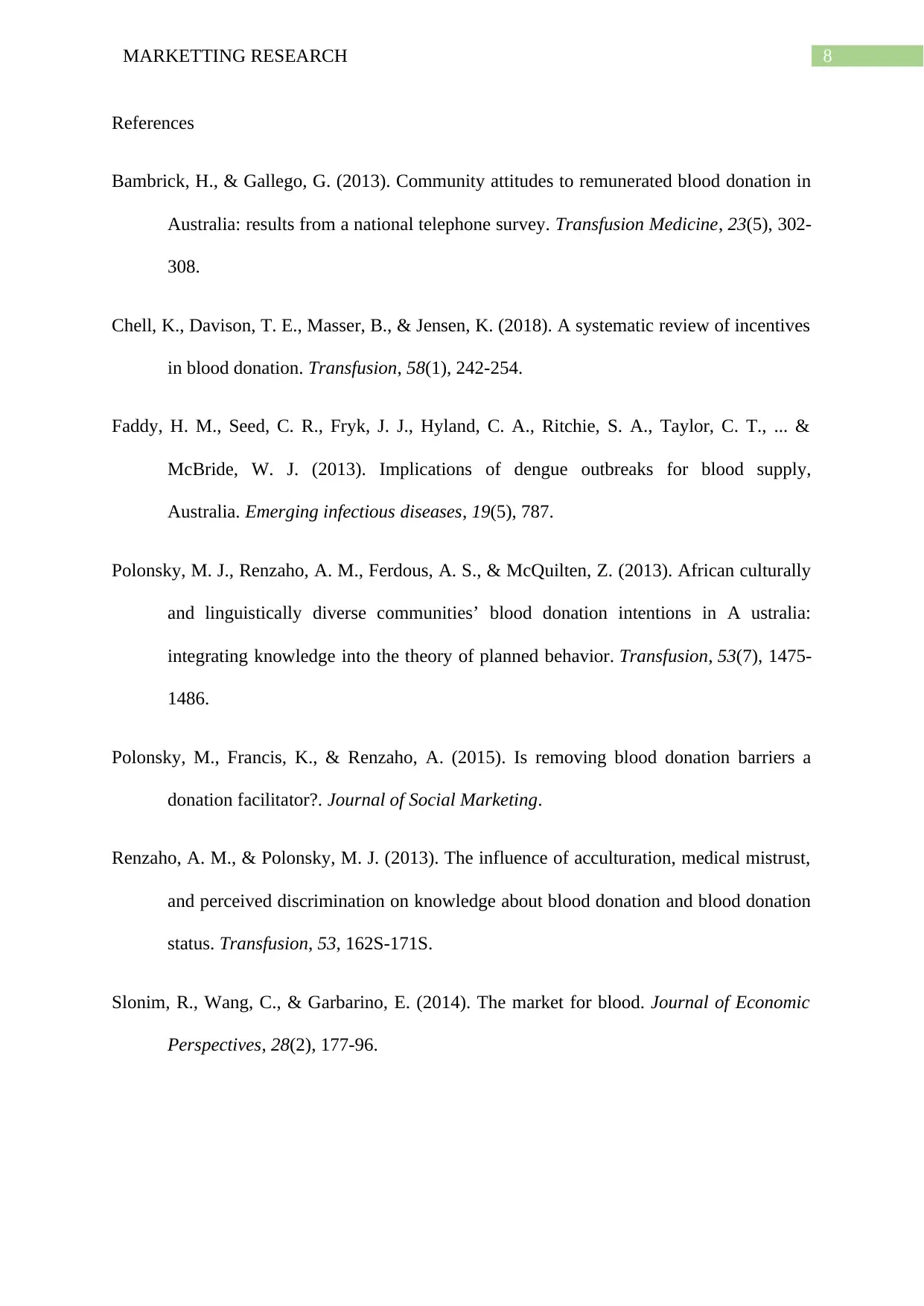
8MARKETTING RESEARCH
References
Bambrick, H., & Gallego, G. (2013). Community attitudes to remunerated blood donation in
Australia: results from a national telephone survey. Transfusion Medicine, 23(5), 302-
308.
Chell, K., Davison, T. E., Masser, B., & Jensen, K. (2018). A systematic review of incentives
in blood donation. Transfusion, 58(1), 242-254.
Faddy, H. M., Seed, C. R., Fryk, J. J., Hyland, C. A., Ritchie, S. A., Taylor, C. T., ... &
McBride, W. J. (2013). Implications of dengue outbreaks for blood supply,
Australia. Emerging infectious diseases, 19(5), 787.
Polonsky, M. J., Renzaho, A. M., Ferdous, A. S., & McQuilten, Z. (2013). African culturally
and linguistically diverse communities’ blood donation intentions in A ustralia:
integrating knowledge into the theory of planned behavior. Transfusion, 53(7), 1475-
1486.
Polonsky, M., Francis, K., & Renzaho, A. (2015). Is removing blood donation barriers a
donation facilitator?. Journal of Social Marketing.
Renzaho, A. M., & Polonsky, M. J. (2013). The influence of acculturation, medical mistrust,
and perceived discrimination on knowledge about blood donation and blood donation
status. Transfusion, 53, 162S-171S.
Slonim, R., Wang, C., & Garbarino, E. (2014). The market for blood. Journal of Economic
Perspectives, 28(2), 177-96.
References
Bambrick, H., & Gallego, G. (2013). Community attitudes to remunerated blood donation in
Australia: results from a national telephone survey. Transfusion Medicine, 23(5), 302-
308.
Chell, K., Davison, T. E., Masser, B., & Jensen, K. (2018). A systematic review of incentives
in blood donation. Transfusion, 58(1), 242-254.
Faddy, H. M., Seed, C. R., Fryk, J. J., Hyland, C. A., Ritchie, S. A., Taylor, C. T., ... &
McBride, W. J. (2013). Implications of dengue outbreaks for blood supply,
Australia. Emerging infectious diseases, 19(5), 787.
Polonsky, M. J., Renzaho, A. M., Ferdous, A. S., & McQuilten, Z. (2013). African culturally
and linguistically diverse communities’ blood donation intentions in A ustralia:
integrating knowledge into the theory of planned behavior. Transfusion, 53(7), 1475-
1486.
Polonsky, M., Francis, K., & Renzaho, A. (2015). Is removing blood donation barriers a
donation facilitator?. Journal of Social Marketing.
Renzaho, A. M., & Polonsky, M. J. (2013). The influence of acculturation, medical mistrust,
and perceived discrimination on knowledge about blood donation and blood donation
status. Transfusion, 53, 162S-171S.
Slonim, R., Wang, C., & Garbarino, E. (2014). The market for blood. Journal of Economic
Perspectives, 28(2), 177-96.
1 out of 8
Related Documents
Your All-in-One AI-Powered Toolkit for Academic Success.
+13062052269
info@desklib.com
Available 24*7 on WhatsApp / Email
![[object Object]](/_next/static/media/star-bottom.7253800d.svg)
Unlock your academic potential
Copyright © 2020–2025 A2Z Services. All Rights Reserved. Developed and managed by ZUCOL.





